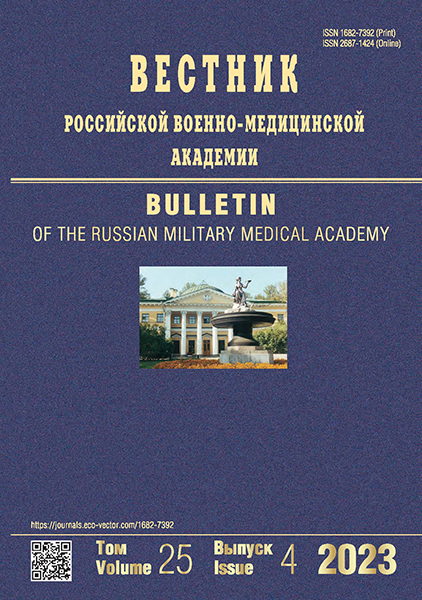The effectiveness of the protocol of focused ultrasound examination of the wounded and injured in combat surgical trauma
- Authors: Lakhin R.E.1, Kusai A.S.1, Usoltsev E.A.2, Kasimov R.R.1,2, Tsygankov K.A.1, Tsvetkov V.G.1, Shustrov V.V.1, Fadeev S.V.3
-
Affiliations:
- Kirov Military Medical Academy
- 442nd Military Clinical Hospital
- 1586nd Military Clinical Hospital (branch No. 3)
- Issue: Vol 25, No 4 (2023)
- Pages: 603-610
- Section: Original Study Article
- Submitted: 28.08.2023
- Accepted: 06.10.2023
- Published: 25.12.2023
- URL: https://journals.eco-vector.com/1682-7392/article/view/568876
- DOI: https://doi.org/10.17816/brmma568876
- ID: 568876
Cite item
Abstract
The provision of medical care in armed conflicts has several features. Ultrasound examination is one of the available and informative diagnostic methods for the wounded and injured under conditions of limited material and technical resources. The sensitivity and specificity of the diagnosis of free fluid in the abdominal cavity and pneumothorax using an extended protocol of focused ultrasound evaluation in wounded patients with combat trauma requiring surgical care were determined. A retrospective cohort study of the medical data of 85 patients with injury and chest and abdominal wounds was performed to identify the extent of damage. For this purpose, a focused ultrasound examination was performed using an extended protocol of focused ultrasound evaluation in patients with wounds and combat trauma. This protocol was applied to all victims with chest and abdominal wounds to identify the extent of damage. The results revealed that the sensitivity and specificity of the extended protocol of focused ultrasound evaluation in the wounded during combat trauma for the diagnosis of free fluid in the abdominal cavity were 100% and 66%, respectively. The sensitivity and specificity of the extended focused ultrasound evaluation protocol for the diagnosis of pneumothorax in the wounded during combat trauma were 87% and 78%, respectively. The results further confirmed the need to use an expanded protocol of focused ultrasound assessment in wounded patients with combat trauma to make decisions on the surgical techniques in settings where other diagnostic methods were not unavailable, particularly during armed conflicts with mass admission of wounded and injured patients. In addition, the use by anesthesiologists or surgeons of an extended focused ultrasound evaluation protocol for wounded patients in combat trauma is important, although teamwork is required when deciding about performing surgery.
Full Text
About the authors
Roman E. Lakhin
Kirov Military Medical Academy
Email: doctor-lahin@yandex.ru
ORCID iD: 0000-0001-6819-9691
SPIN-code: 7261-9985
MD, Dr. Sci. (Med.)
Russian Federation, Saint PetersburgAlexander S. Kusai
Kirov Military Medical Academy
Email: doctorcygankov@mail.ru
ORCID iD: 0000-0002-0668-9676
SPIN-code: 8843-5840
Head of Department
Russian Federation, Saint PetersburgEvgeniy A. Usoltsev
442nd Military Clinical Hospital
Email: doctorcygankov@mail.ru
ORCID iD: 0000-0001-6497-1429
SPIN-code: 3460-8662
anesthesiologist-resuscitator
Russian Federation, Saint PetersburgRustam R. Kasimov
Kirov Military Medical Academy; 442nd Military Clinical Hospital
Email: rusdoc77@mail.ru
ORCID iD: 0000-0001-5866-8378
SPIN-code: 5682-2810
MD, Cand. Sci. (Med.)
Russian Federation, Saint Petersburg; Saint PetersburgKirill A. Tsygankov
Kirov Military Medical Academy
Author for correspondence.
Email: doctorcygankov@mail.ru
ORCID iD: 0000-0002-2357-0685
SPIN-code: 7133-0503
MD, Cand. Sci. (Med.)
Russian Federation, Saint PetersburgVasiliy G. Tsvetkov
Kirov Military Medical Academy
Email: vasilii_cvetkov@mail.ru
ORCID iD: 0000-0003-4980-597X
SPIN-code: 5316-4617
Scopus Author ID: 1119527
senior resident
Russian Federation, Saint PetersburgVyacheslav V. Shustrov
Kirov Military Medical Academy
Email: shustrov@anesthvmeda.ru
ORCID iD: 0000-0001-5144-3360
SPIN-code: 5955-7492
lecturer of the Department
Russian Federation, Saint PetersburgSergey V. Fadeev
1586nd Military Clinical Hospital (branch No. 3)
Email: doctorcygankov@mail.ru
ORCID iD: 0009-0002-6122-4772
SPIN-code: 1043-7366
Head of the surgical Department
Russian Federation, Naro-FominskReferences
- Gaiduk SV, Ovchinnikov YuV, Khalimov YuSh, Gaiduk VA. Cardio-respiratory pathology in wounded in counter-terroristic operation in сhechnya. Bulletin of the Russian Military Medical Academy. 2016;1(53):22–28. (In Russ.).
- Polushin YuS. Anesteziologicheskaya i reanimatologicheskaya pomoshch’ ranenym na voine. Saint Petersburg: ELBI; 2003. 288 р. (In Russ.).
- Trishkin DV, Kryukov EV, Chuprina AP, et al. Metodicheskie rekomendatsii po lecheniyu boevoi khirurgicheskoi travmy. Moscow: GVMU MO RF; 2022. 373 р. (In Russ.).
- Zhirnova EA, Lakhin RE, Shchegolev AV, Grachev IN. Comparison of ultrasound protocols in diagnostic of lesions of pneumonia. Bulletin of the Russian Military Medical Academy. 2019;4(68):28–34. (In Russ.).
- Lakhin RE, Zhirnova EA, Shchegolev AV, et al. Specificity and sensitivity of lung ultrasound examination in patients with COVID-19 induced pneumonia. Messenger of Anesthesiology and Resuscitation. 2022;19(3):7–14. (In Russ.). doi: 10.21292/2078-5658-2022-19-3-7-14
- Bockler D, Hatzl J, Bischoff MS, et al. Intra-abdominal vascular injuries after blunt abdominal trauma. Chirurgie (Heidelb). 2023;94(8):696–702. doi: 10.1007/s00104-023-01931-9
- Bradley CA, Hollon MM. Ultrasound rounds: anesthesiologist-performed intraoperative point-of-care focused assessment with sonography in trauma examination changes surgical management. A A Pract. 2023;17(8):e01707. doi: 10.1213/XAA.0000000000001707
- Devadoss H, Sharma P, Nair VV, et al. Diagnostic accuracy of e-FAST in stable blunt trauma chest: a prospective analysis of 110 cases at a Tertiary Care Center. Indian J Crit Care Med. 2021;25(10):1167–1172. doi: 10.5005/jp-journals-10071-23995
- Netherton S, Milenkovic V, Taylor M, Davis PJ. Diagnostic accuracy of eFAST in the trauma patient: a systematic review and meta-analysis. CJEM. 2019;21(6):727–738. doi: 10.1017/cem.2019.381
- Brun PM, Bessereau J, Chenaitia H. Stay and play eFAST or scoop and run eFAST? That is the question! Am J Emerg Med. 2014;32(2):166–170. doi: 10.1016/j.ajem.2013.11.008
- Nunes LW, Simmons S, Hallowell MJ, et al. Diagnostic performance of trauma US in identifying abdominal or pelvic free fluid and serious abdominal or pelvic injury. Acad Radiol. 2001;8(2): 128–136. doi: 10.1016/s1076-6332(01)90057-1
- Jonathan DM, Perreault MD. Impact of a 4-hour introductory eFAST training intervention among ultrasound-naïve U.S. Military Medics. Mil Med. 2020;185(5–6):e601–e608. doi: 10.1093/milmed/usaa014
- LaDuke M, Monti J, Cronin A, Gillum B. Ultrasound detection of soft tissue abscesses performed by non-physician U.S. Army Medical Providers Naïve to Diagnostic Sonography. Mil Med. 2017;182(3):e1825–e1830. doi: 10.7205/MILMED-D-16-00306
- Lakhin RE. Ultrasound in anesthesiology and intensive care: what to teach? Russian Journal of Anaesthesiology and Reanimatology. 2016;61(4):263–265. (In Russ.). doi: 10.18821/0201-7563-2016-61-4-263-265
- Monti JD, Younggren B, Blankenship R. Ultrasound detection of pneumothorax with minimally trained sonographers: a preliminary study. J Spec Oper Med. 2009;9(1):43–46. doi: 10.55460/9GWU-MQO4
Supplementary files









